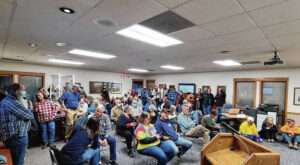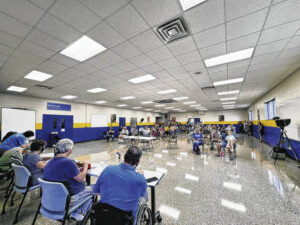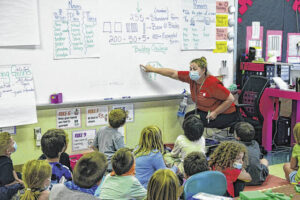By SUZANNAH COUCH and ABIGAIL YOUMANS
Narrowing down 2021 to just 10 top stories is by no means an easy task.
Though Brown County is small, the news supply is often mighty. The Democrat has covered everything from house fires, business, crime, government, arts and entertainment and much more.
This year, stories that made the cut for the “Top Ten” list include a second year of adjusting to COVID-19, new developments across the county, a wide variety of change within the school system and individual slain on a road he called home for decades — to name a few.
This past year was another newsworthy year for Brown County and we look forward to 2022, no matter what the headlines may be.
1. COVID-19 continues into 2021

For nearly two years now the COVID-19 pandemic has affected life on all levels. In Brown County it meant long lines for vaccines or tests, continued pop-up food pantries, millions of dollars in relief funding to local government and continued positive cases and deaths reported.
Some sense of normalcy also returned this year with annual events like the Brown County Fair and the Holiday Lights Parade returning along with live music and other programs at local entertainment venues. Fans returned to the stands of school athletic events this school year, too.
The Brown County Music Center was the site of the county health department’s vaccine clinic beginning in January with residents being the first in line to get a dose.
In March the Brown County Democrat spoke with locals who were impacted by the pandemic and shared their stories on how the past year had changed their lives. Some lost parents while others learned how to parent in a pandemic. Older residents struggled with being alone during quarantine and young residents in high school spoke about how COVID-19 had affected their lives at school and beyond.
Local government received millions of dollars in funding from the American Rescue Plan and plans were discussed throughout the year on how to best spend the money within the parameters. Recently the Brown County Commissioners and Brown County Council approved onetime bonuses for all county employees who worked during the pandemic along with a $2 an hour raise for essential employees for the next four years, like those in the health department and sheriff’s department.
Schools were forced to momentarily close their doors this school year and the latter half of the previous school year due to rising positive cases or the percentage of students and staff with symptoms of the virus. Teachers and staff received $1,000 stipends in June for working in the pandemic.
Brown County was not immune to rising numbers of positive COVID-19 cases either. Throughout the year the county fluctuated from blue to yellow to orange to red on the Indiana State Department of Health’s COVID-19 virus spread map with red being the highest level. At the beginning of the year the county reported a total of 760 people who had tested positive since March 2020. As of Dec. 20 that number was 1,913.
Moving into the different color-coded levels on the spread map has not resulted in any additional restrictions from county or town government though as both have not issued additional mandates related to COVID-19.
The county reported nine deaths as of Jan. 4 this year. That number is now 50.
To commemorate the lives lost to the virus in Brown County Health and Living nursing facility a butterfly release was held in May.
The county health department worked with the state department of health to host drive-thru testing and vaccine clinics in the county as cases continued to rise in the latter half of the year.
A move to Hawthorne Drive also happened for the health department to allow for more space for testing and vaccines after shows returned to the music center in September.
Businesses continued to adjust to the pandemic and everything that came along with it, including a shortage in employees resulting in some establishments opting to be open less days and hours.
It does not seem the pandemic is slowing down soon as the first COVID-19 case involving the recently discovered omicron variant was reported in Indiana on Dec. 19.
The percentage of the population who is now partially vaccinated against COVID-19 was 56 percent as of Dec. 21. Health officials say that getting vaccinated remains the best defense against COVID-19.
2. New developments prompt questions about future of county
Coming soon to Brown County are a tiny house campground, a new resort, an apartment complex and an outdoor sports outfitter facility along with a couple of wedding barns.

The Brown County Board of Zoning Appeals approved a 45-unit travel trailer campground in Van Buren Township in June. Guests will be able to stay in tiny house-like units that are a cross between a cabin and an RV.
In October, the Brown County Area Plan Commission approved Harmony Tree Resort, an eco-friendly visitor destination offering 200 lodging opportunities on the 56-acre site that was once Rawhide Ranch off of State Road 135 South.
The same month, the BZA denied a special exception to allow a 185-spot luxury RV campground on Old State Road 46. The property owner, Stephen Alexander, adjusted his plans and has so far received the necessary approvals from town government to build a maintenance building, an outdoor sports outfitter facility and event space on the 71.6-acre parcel. The buildings will be built in the floodplain.
But along with the approval of some of these new developments came questions from residents and government officials alike about the future direction of the county and the impact such developments have on neighbors.
At each zoning meeting neighbors to the projects showed up to share their concerns about traffic, flooding, safety, the impact developments would have on resources in the county, like the volunteer fire departments and county roads, and how approving zoning changes could allow for unexpected business use on properties near residential properties.
Two wedding barns were also approved on Old Settlers Road and Bellsvillike Pike over objections from neighbors who own homes nearby.
A discussion and vote in September for a wedding barn on Bellsville Pike spurred comments from BZA President John Dillberger about how the county’s comprehensive plan and zoning ordinances need updated so that members are not tasked with granting multiple special exceptions, like this one, that have been more common recently. Dillberger voted against both wedding barns.
Dillberger said he was “conflicted” with special exceptions to approve a business on a residential property near other similar properties. He said if the county’s zoning ordinance is revised then input could be received from residents about what they think development should look like in the county “rather than the five of us deciding whether or not we think this looks like a good place for business.”
This fall it was also announced that two apartment buildings would be built on the former Little Nashville Opry property, which has set vacant since 2009. The property owner, Andrew Tilton, said he wanted to build the apartments to help with the housing issue in the county. Often times it has been said there is not enough affordable housing in the county to bring in younger families to live, go to school and work here.
Tilton said he has been slowly acquiring properties that have been underutilized and is working with others to make them into something new.
3. Resident killed in slaying on Helms Road

Family and friends of resident Robert “Bob” Adair mourned the loss of the animal lover, master woodworker and musician who would do anything for anyone after he was killed on a road he had called home for decades.
Police say Adair’s life was ended at the hands of a neighbor who shot Adair over a mailbox dispute while Adair sat in his truck. Randy Small, 56, was formally charged with murder on Sept. 22. He is being held without bail at the Brown County jail.
Just after midnight Sept. 16, deputies with the Brown County Sheriff’s Department were dispatched to the 4500 block of Helms Road for a report of someone who had been shot. A relative of Small’s said that the homeowner was wishing to commit suicide by police. Officers surrounded the home and gave commands for Small to come out. After about 30 minutes, Small complied.
Officers could not find an injured or deceased person in Small’s home.
While Small was being transported to the hospital for treatment, a relative informed authorities that Small had told them he shot Adair the afternoon of Sept. 15 and police found Adair’s truck in the grass alongside Helms Road. Adair was inside the truck, deceased.
Small had told his relative that he shot Adair in self-defense. He had said that Adair had a gun and he thought he was going to shoot him, so he shot Adair first.
No gun was found in Adair’s vehicle. Based on evidence found at the scene, police believe Small shot Adair from an elevated position. They also found tractor tire prints appearing to have run over the mailbox post that was next to Adair’s truck. Blood evidence was also found on one of Small’s shoes and his tractor.
A jury trial has been scheduled for Feb. 2.
Adair had one daughter, Lauren, who lives in Indianapolis with her husband and two children. Adair would drive to Indianapolis to see his grandson Tyrion play baseball and basketball. Lauren and Tyrion had last visited Adair over Labor Day weekend.
Adair helped to start the Brown County Craft Gallery with his ex-wife and friend Martha Burton who described Bob as a multi-talented and an excellent woodworker.
He had lived in Brown County since 1972. He played the dobro with the White Lightning Boys.
“He was an artisan and musician, a nature-loving hippie and a country boy. He worked hard, played hard, had a wicked sense of humor, and loved and appreciated life and the beauty around him. His essence was the same one that runs through the veins of the county,” said Rainey Wyatt, Lauren’s best friend.
4. Do Something Inc.
It was announced in February that the Do Something Inc. Launch House Recovery Engagement Center would get a new headquarters at 161 E. Gould St. It was to be called the Carol Lynn House, and Launch House was going to be able to operate in the state-of-the-art building for free.
In April, plans were changed and the Launch House was to move next door to 153 E. Gould St. The property owner, Ted Seastrom, gifted 153 E. Gould to Do Something Inc.
Do Something Inc. created the Launch House as a space in the community where anyone could go to find help overcoming addiction, for themselves or a loved one. The nonprofit Do Something was created by Michelle and Cory Joy following the loss of their oldest son to a heroin overdose in 2017.
For several months, Do Something Inc. had been trying to raise the money necessary to buy and renovate its location at 161 E. Gould St., but COVID-19 prevented fundraising from happening. The group continued to rent the building while it was for sale. The Launch House is not open yet in its new location, but more updates are expected in 2022, Cory said.
Do Something Inc. was also one of several local subjects in “The Addict’s Wake” documentary that premiered in October and features stories of substance use disorder and recovery in Brown County.

It was shown at the 30th annual Heartland Film Festival Oct. 11 and was the winner of the Indiana Spotlight Category.
Following the film, the Joys, along with the director, producer and executive producer Lisa Hall were presented with Distinguished Hoosier awards from Gov. Eric Holcomb’s office.
The Distinguished Hoosier has been awarded by Indiana governors for more than 50 years to recognize outstanding Indiana residents.
5. School mask policy debate
The COVID-19 divide in the county was further exemplified at the start of this school year when the decision to require students and staff to wear masks despite their vaccination status was approved by the Brown County School Board of Trustees.
The board vote to reinstate mask wearing following an hour of comments in August.
Nearly 60 people filled the Brown County High School cafeteria on Aug. 12 for the special school board meeting called to approve changes to the educational service delivery plan which was initially approved in July.

Originally, the plan did not require masks for students and staff; it only recommended them for those who were not vaccinated. But on the first day of school Aug. 4, the school district had its first COVID-19 positive case followed by more cases being reported the first few days of school.
Parents received a message about mandatory masking on Friday night, Aug. 6, to start on Monday, Aug. 9. That Monday morning, groups of about 15 parents and students protested the rule outside the high school.
Following the approval of the change, concerned parents and students continued to attend school board meetings to speak out against the mask mandate. Arguments included health concerns around requiring children to wear masks for an extended period of time and the effectiveness of mask wearing.
In September, the school board approved more changes to the district’s COVID-19 educational service delivery plan, including to the daily metric report that helps to determine when a building will have to close due to COVID-19.
Now a building will now only be considered for closure, or be put on “red level,” if 16 percent of the building population is reporting COVID-19 symptoms for at least two days. Previously a building would be closed if 20 percent or more of the building population was absent due to testing positive for COVID-19, having symptoms, being identified as a close contact or were awaiting test results.
As of Dec. 23, all schools were operating in-person. The mask mandate also remains in place.
6. Van Buren Elementary School named Blue Ribbon School
Van Buren Elementary School was named a 2021 National Blue Ribbon School this year.
The news was announced on Sept. 21 by the U.S. Department of Education. The school was nominated for the honor by the Indiana Department of Education in February. Van Buren was one of seven in the state to and one of 325 in the nation to be awarded with the honor.

The state nomination designated VBE as an “Exemplary Achievement Gap Closing School.” This means VBE was in the top 15 percent of schools who closed achievement gaps for English and mathematics for students groups, including those are low income and in special education, over the past three to five years. The achievement was measured by state assessments, like ILEARN.
After being nominated, schools had to complete an application detailing curriculum, culture, leadership and engagement, which was then evaluated by the U.S. Department of Education.
The last school to receive this honor in Brown County was Sprunica Elementary School in 2014.
7. Law enforcement funding, pay raises
The funding of county and town law enforcement agencies was a hot topic in 2021.
Since 2013, the Brown County Sheriff’s Department has lost an average of one deputy per year, which costs the county money when investing in training for that officer and even more money if the officer had training certifications. The number of applicants for open positions has also declined, with deputies able to make more in other counties.
Brown County Council began taking a closer look at what options were to bridge the pay gap and keep trained officers in the county in January.
In August, the county council approved an increase in pay for officers, basing their pay on a percentage of the county prosecutor’s salary. Sheriff’s deputies also received the 1-percent raise the council approved for all county employees this year. They will also continue to receive incentive pay if they do extracurricular trainings.

The current base salary for the sheriff’s department in 2021 is around $43,173. The average salary of police agencies surrounding Brown County is $54,299. Under the new pay scale, a deputy will be paid $52,784 a year.
Funding of the Nashville Police Department also came under discussion by Nashville Town Council this year.
Town clerk-treasurer Brenda Young said that a little over 66 percent of the 2021 general fund budget for the town goes to the police department.
NPD’s budget first came under discussion in August during a 2022 budget work session. At least 60 people were at the work session to talk about a proposal thought to be before the council to defund or cut the budget of the town police department, but no such proposal had been discussed at any public council meeting this year.
Despite this, an online petition against the potential budget threat had gathered close to 500 signatures and yards signs had begun to pop up north of town to “Save Nashville PD.”
Council members had been asking questions about the budget, how money is being used and what they get for that money. Those discussions will continue as the town works to ensure there is enough money to provide other important services, like water, sewer and good roads.
The department has been struggling for years with high turnover as officers leave for higher-paying jobs with other police forces. In the Nov. 18 meeting, Seastrom said he was losing three of his six full-time officers at the end of the year.
In 2020, full-time town police officers made between $28,760 and $42,966, with $36,224 being the average. Police Chief Ben Seastrom made $52,151.80.
Budget talks continued from August through November when the 2022 budget was ultimately adopted. In the end, the police department’s budget was not reduced and will make up more than 50 percent of the town’s general fund at $422,118 for 2022. Officers will also receive raises in 2022.
Following the budget adoption, council President Jane Gore released a press release stating that the council has not “held a discussion or made any decisions concerning any future changes with the Nashville Metropolitan Police Department at this time.” Gore issued the release to dispel rumors about the future of the department, she said.
8. School administration changes

Big changes happened this school year in the administration of Brown County Schools.
Former Superintendent Laura Hammack announced her resignation in April to take over as superintendent of Beech Grove Schools.
Hammack became Brown County Schools superintendent after David Shaffer’s retirement in 2016. She had served as assistant superintendent for Beech Grove Schools since July 2009. Hammack was also assistant superintendent under Shaffer from July 2007 to July 2009.
She had begun her education career here in Brown County as a special education teacher.
Jim Halik was hired in as an interim superintendent in May to fill the role until a permanent hire could be found. In July, Emily Tracy was hired as Hammack’s replacement. She had previously served in Wabash City Schools as director of curriculum and instruction as well as the interim superintendent. She went to Ball State University where she earned her bachelor’s and master’s degrees.
In August, Brown County High School Principal Matt Stark announced his resignation and plans to be the Bloomington High School North principal. He was initially hired at the school right after graduating Purdue University to teach social studies, which he did for 10 years, then was principal at the school for another 10. He left the district briefly in 2013 to take a principal job in Urbana High School in Illinois before returning to Brown County in 2018.
When news of Stark leaving hit Facebook in July, some commenters asked why he was not hired as the superintendent for Brown County Schools. Stark said that he did not have his superintendent’s license and was excited for Brown County Schools to have Tracy as the next superintendent.
Stark’s replacement, Trent Austin, took the helm on Aug. 9, but was no stranger to the school system. He was principal at Brown County Intermediate School, which closed at the end of the 2020-2021 school year. He was moved to the new middle school to serve alongside Principal Brian Garman before going to BCHS to be principal there.
Austin graduated from BCHS in 1993.
By taking on this role, Austin said he has now expanded his principal experience from kindergarten to 12th grade. He served as principal at Sprunica Elementary School for three months when former principal Abbie Oliver was on leave due to an injury.
9. Intermediate school closes, Educational Service center opens
Big changes to Brown County Schools this year were not limited to administration. A school building also closed.
The Brown County Intermediate School closed its door to elementary students at the end of last school year to help the budget due declining student enrollment and state funding. The Brown County Schools Board of Trustees approved the 10-year plan at the February board meeting, authorizing the closure of BCIS.

Projections presented earlier this year showed the district losing more than $1.2 million in state funding by school year 2023-2024.
BCIS served all fifth- and sixth-graders. It was created in 2013 when Nashville Elementary School was closed to help with a $1 million deficit the district was facing at that time.
With the change, current fourth-graders remained in their elementary schools for fifth grade. Fifth-graders last school year moved to the junior high this school year, which was renamed Brown County Middle School. The middle school now serves all the district’s sixth- through eighth-graders.
To keep the number of certified staff in line with the closure and to avoid firing teachers, retirement incentives were offered to teachers and non-certified staff like custodians.
BCIS was repurposed into the “Educational Service Center” — the new home of the Brown County Career Resource Center – and it opened in October. A preschool is expected to open there in July with the goal of being the spot to educate people of all ages.
The plan presented in February was to sell the old CRC building on Main Street and use the money to help renovate BCIS to better serve adult learners. In June, Brown County Commissioners put an offer in to purchase the building and move the Brown County Prosecutors Office there, but ultimately did not move forward with the purchase. Brown County Schools Superintendent Emily Tracy said in October there are no solidified plans for that building yet.
10. New humane society shelter opens its doors

In June, the new, $3.2 million Brown County Humane Society shelter welcomed its first furry occupants.
The humane society shelter operated next door to this new building for more than 30 years. Supporters managed to raise more than $3.2 million for the new shelter in less than three years; construction started during the pandemic.
A second fundraising initiative brought in $225,000 to cover the furnishings. Money was raised through a combination of donations, grants and support from foundations, with the majority coming from personal donations.
The result is a “healthier, safer and more comfortable environment for everyone.”
The new shelter features a lobby, a medical room, an education room and wings for dogs and cats featuring “catios,” kennels, meet-and-greet rooms and a room for grooming. There are also a fenced-in outdoor areas.




